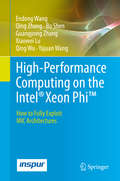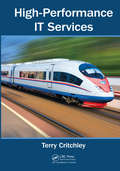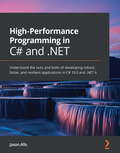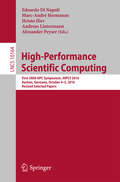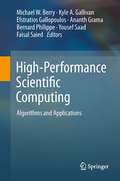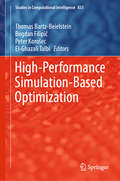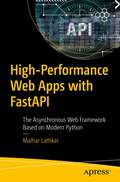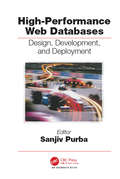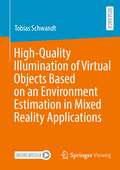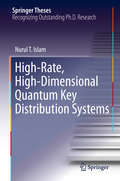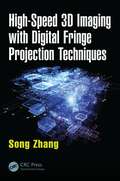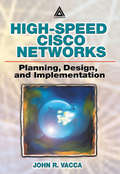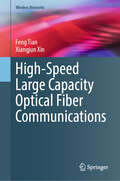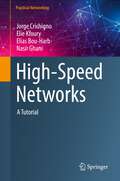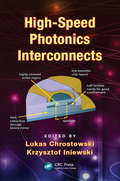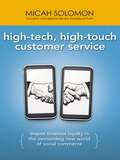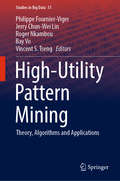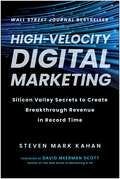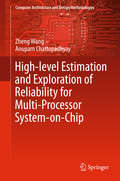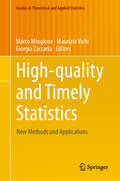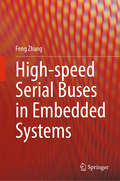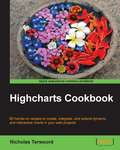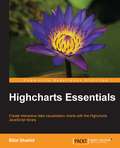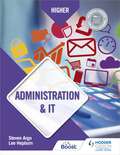- Table View
- List View
High-Performance Computing on the Intel® Xeon PhiTM
by Bo Shen Qing Zhang Endong Wang Guangyong Zhang Xiaowei Lu Qing Wu Yajuan WangThe aim of this book is to explain to high-performance computing (HPC) developers how to utilize the Intel® Xeon Phi(tm) series products efficiently. To that end, it introduces some computing grammar, programming technology and optimization methods for using many-integrated-core (MIC) platforms and also offers tips and tricks for actual use, based on the authors' first-hand optimization experience. The material is organized in three sections. The first section, "Basics of MIC", introduces the fundamentals of MIC architecture and programming, including the specific Intel MIC programming environment. Next, the section on "Performance Optimization" explains general MIC optimization techniques, which are then illustrated step-by-step using the classical parallel programming example of matrix multiplication. Finally, "Project development" presents a set of practical and experience-driven methods for using parallel computing in application projects, including how to determine if a serial or parallel CPU program is suitable for MIC and how to transplant a program onto MIC. This book appeals to two main audiences: First, software developers for HPC applications - it will enable them to fully exploit the MIC architecture and thus achieve the extreme performance usually required in biological genetics, medical imaging, aerospace, meteorology and other areas of HPC. Second, students and researchers engaged in parallel and high-performance computing - it will guide them on how to push the limits of system performance for HPC applications.
High-Performance IT Services
by Terry CritchleyThis book on performance fundamentals covers UNIX, OpenVMS, Linux, Windows, and MVS. Most of the theory and systems design principles can be applied to other operating systems, as can some of the benchmarks. The book equips professionals with the ability to assess performance characteristics in unfamiliar environments. It is suitable for practitioners, especially those whose responsibilities include performance management, tuning, and capacity planning. IT managers with a technical outlook also benefit from the book as well as consultants and students in the world of systems for the first time in a professional capacity.
High-Performance Programming in C# and .NET: Understand the nuts and bolts of developing robust, faster, and resilient applications in C# 10.0 and .NET 6
by Jason AllsEnhance your applications' performance using best practices for benchmarking, application profiling, asynchronous programming, designing responsive UIs, gRPC communication, and distributed applicationsKey FeaturesMake the best use of performance enhancements in C# 10.0 and .NET 6Boost application performance by identifying hardware bottlenecks and common performance pitfallsGet to grips with best practices and techniques for improving the scalability of distributed systemsBook DescriptionWriting high-performance code while building an application is crucial, and over the years, Microsoft has focused on delivering various performance-related improvements within the .NET ecosystem. This book will help you understand the aspects involved in designing responsive, resilient, and high-performance applications with the new version of C# and .NET.You will start by understanding the foundation of high-performance code and the latest performance-related improvements in C# 10.0 and .NET 6. Next, you'll learn how to use tracing and diagnostics to track down performance issues and the cause of memory leaks. The chapters that follow then show you how to enhance the performance of your networked applications and various ways to improve directory tasks, file tasks, and more. Later, you'll go on to improve data querying performance and write responsive user interfaces. You'll also discover how you can use cloud providers such as Microsoft Azure to build scalable distributed solutions. Finally, you'll explore various ways to process code synchronously, asynchronously, and in parallel to reduce the time it takes to process a series of tasks.By the end of this C# programming book, you'll have the confidence you need to build highly resilient, high-performance applications that meet your customer's demands.What you will learnUse correct types and collections to enhance application performanceProfile, benchmark, and identify performance issues with the codebaseExplore how to best perform queries on LINQ to improve an application's performanceEffectively utilize a number of CPUs and cores through asynchronous programmingBuild responsive user interfaces with WinForms, WPF, MAUI, and WinUIBenchmark ADO.NET, Entity Framework Core, and Dapper for data accessImplement CQRS and event sourcing and build and deploy microservicesWho this book is forThis book is for software engineers, professional software developers, performance engineers, and application profilers looking to improve the speed of their code or take their skills to the next level to gain a competitive advantage. You should be a proficient C# programmer who can already put the language to good use and is also comfortable using Microsoft Visual Studio 2022.
High-Performance Scientific Computing
by Marc-André Hermanns Hristo Iliev Andreas Lintermann Alexander Peyser Edoardo Di NapoliThis book constitutes the thoroughly refereed post-conference proceedings of the First JARA High-Performance Computing Symposium, JARA-HPC 2016, held in Aachen, Germany, in October 2016.The 21 full papers presented were carefully reviewed and selected from 26 submissions. They cover many diverse topics, such as coupling methods and strategies in Computational Fluid Dynamics (CFD), performance portability and applications in HPC, as well as provenance tracking for large-scale simulations.
High-Performance Scientific Computing
by Kyle A. Gallivan Ananth Grama Faisal Saied Bernard Philippe Efstratios Gallopoulos Michael W. Berry Yousef SaadThis book presents the state of the art in parallel numerical algorithms, applications, architectures, and system software. The book examines various solutions for issues of concurrency, scale, energy efficiency, and programmability, which are discussed in the context of a diverse range of applications. Features: includes contributions from an international selection of world-class authorities; examines parallel algorithm-architecture interaction through issues of computational capacity-based codesign and automatic restructuring of programs using compilation techniques; reviews emerging applications of numerical methods in information retrieval and data mining; discusses the latest issues in dense and sparse matrix computations for modern high-performance systems, multicores, manycores and GPUs, and several perspectives on the Spike family of algorithms for solving linear systems; presents outstanding challenges and developing technologies, and puts these in their historical context.
High-Performance Simulation-Based Optimization (Studies in Computational Intelligence #833)
by El-Ghazali Talbi Peter Korošec Thomas Bartz-Beielstein Bogdan FilipičThis book presents the state of the art in designing high-performance algorithms that combine simulation and optimization in order to solve complex optimization problems in science and industry, problems that involve time-consuming simulations and expensive multi-objective function evaluations. As traditional optimization approaches are not applicable per se, combinations of computational intelligence, machine learning, and high-performance computing methods are popular solutions. But finding a suitable method is a challenging task, because numerous approaches have been proposed in this highly dynamic field of research. That’s where this book comes in: It covers both theory and practice, drawing on the real-world insights gained by the contributing authors, all of whom are leading researchers. Given its scope, if offers a comprehensive reference guide for researchers, practitioners, and advanced-level students interested in using computational intelligence and machine learning to solve expensive optimization problems.
High-Performance Web Apps with FastAPI: The Asynchronous Web Framework Based on Modern Python
by Malhar LathkarBuild APIs and web apps based on Asynchronous Server Gateway Interface (ASGI). This book provides a comprehensive explanation of using Pydantic models to construct the request/response objects in a FASTAPI path operation. You’ll start by reviewing type hints in Python and the asynchronous processing concepts. One of the highlights of FastAPI is its auto generation of API docs. Pydantic library is the main pillar on top of which FastAPI is built. You’ll see that ASGI has a far better performance compared to most of the other popular Python frameworks as they implement Web server Gateway Interface (WSGI), which is synchronous in nature and hence having slower response time. This book thoroughly explains how FastAPI interacts asynchronously with relational as well as NOSQL databases. Modern web apps use template engines to interact with the front-end. In this book, you will learn to use jinja2 templates and static assets. Swagger UI and OpenAPI standards are also covered in detail. Finally, different options of deployment of FastAPI app have been explored in this book. This book uses practical examples to empower you to build high performance APIsWhat You'll LearnDevelop robust and high-performance web appsDeploy the FastAPI app for public availability using cloud services such as Deta and Docker containerUnderstand the important building blocks of a web app such as form handling, templating and database interactionWho This Book Is ForAspiring and the experienced Python developers looking to leverage the flexibility of Python and the powerful features introduced in Modern Python. Computer science Engineering students at graduate and postgraduate level will also benefit immensely from the practical approach adapted in the book.
High-Performance Web Databases: Design, Development, and Deployment
by Sanjiv PurbaAs Web-based systems and e-commerce carry businesses into the 21st century, databases are becoming workhorses that shoulder each and every online transaction. For organizations to have effective 24/7 Web operations, they need powerhouse databases that deliver at peak performance-all the time. High Performance Web Databases: Design, Development, and
High-Quality Illumination of Virtual Objects Based on an Environment Estimation in Mixed Reality Applications
by Tobias SchwandtVisualizations of virtual objects in the real environment is often done by a simplified representation with simple surfaces and without reference to the surrounding environment. The seamless fusion of the virtual and real environment is, however, an essential factor in many areas, which is of particular importance when calculating lighting in mixed realities on mobile devices. Current approaches focus on approximations, which allow the calculation of diffuse lighting, whereby the rendering of glossy reflection properties is often neglected. The aim of this book is to enable the visualization of mirror-like reflective surfaces in mixed reality. In order to achieve this goal, various approaches are explored enabling high-quality visualization of virtual objects in realtime with a focus on the use of common hardware such as cameras, sensors in mobile devices, and partially depth sensors. Complete ambient lighting can be estimated, which enables detailed reflections. The results provide a novel way to embed complex and simple geometric shapes with glossy surfaces in the real world which offers a higher level of detail in the reflections without using additional hardware.
High-Rate, High-Dimensional Quantum Key Distribution Systems (Springer Theses)
by Nurul T. IslamThis book describes a broad research program on quantum communication. Here, a cryptographic key is exchanged by two parties using quantum states of light and the security of the system arises from the fundamental properties of quantum mechanics. The author developed new communication protocols using high-dimensional quantum states so that more than one classical bit is transferred by each photon. This approach helps circumvent some of the non-ideal properties of the experimental system, enabling record key rates on metropolitan distance scales. Another important aspect of the work is the encoding of the key on high-dimensional phase-randomized weak coherent states, combined with so-called decoy states to thwart a class of possible attacks on the system. The experiments are backed up by a rigorous security analysis of the system, which accounts for all known device non-idealities. The author goes on to demonstrate a scalable approach for increasing the dimension of the quantum states, and considers attacks on the system that use optimal quantum cloning techniques. This thesis captures the current state-of-the-art of the field of quantum communication in laboratory systems, and demonstrates that phase-randomized weak coherent states have application beyond quantum communication.
High-Speed 3D Imaging with Digital Fringe Projection Techniques (Optical Sciences and Applications of Light)
by Song ZhangDigital fringe projection (DFP) techniques are used for non-contact shape measurement of 3D images. In the rapidly expanding field of 3D high-speed imaging, the demand for DFP continues to grow due to the technology’s fast speed, flexibility, low cost, and high accuracy.High-Speed 3D Imaging with Digital Fringe Projection Techniques discusses the generation of digital fringe with digital video projection devices, covering a variety of core technical aspects. The book begins by establishing the theoretical foundations of fringe pattern analysis, reviewing various 3D imaging techniques while highlighting the advantages of DFP. The author then: Describes the differences between digital light processing (DLP), liquid crystal display (LCD), and liquid crystal on silicon (LCoS) Explains how to unwrap phase maps temporally and spatially Shows how to generate fringe patterns with video projectors Demonstrates how to convert phase to coordinates through system calibrations Provides a detailed example of a built-from-scratch 3D imaging system Incorporating valuable insights gained during the author’s 15+ years of 3D imaging research, High-Speed 3D Imaging with Digital Fringe Projection Techniques illuminates the pathway to advancement in high-speed 3D optical imaging using DFP.
High-Speed Cisco Networks: Planning, Design, and Implementation
by John R. VaccaHigh-Speed Cisco Networks: Planning, Design, and Implementation covers LAN/WAN technology and its benefits. The book lays out Cisco's complete line of products and describes their features and best applications. It provides critical details on routers and servers, switches and hubs, security products, network management tools, ATM products, other services and programs, and Internetwork Operating Systems (IOS). Cisco's routers, hubs, and switches are the core of the Internet and today's high-speed networks. Armed with this independent evaluation, the reader can design high-speed networks that meet current needs and scale to future requirements with confidence.
High-Speed Large Capacity Optical Fiber Communications (Wireless Networks)
by Feng Tian Xiangjun XinThis book systematically explores the synergistic integration of multidimensional modulation and coding technology, extend wavelength division multiplexing, space division multiplexing (SDM) and signal processing techniques to unlock unprecedented transmission capacities. From foundational principles to experimental validations, this book bridges theoretical concepts with practical implementations, offering a holistic view of scalable solutions for next-generation optical networks. Delving into both established and emerging paradigms, this book develops the key technology of improving the capacity of the transmission. It covers hybrid concatenated coding schemes, multi-carrier generation or multi-band transmission in achieving terabit-scale throughputs. This book also examines the role of self-homodyne coherent systems, SDM transmission system and the channel damage compensation algorithms, illustrates the real-world applicability of these technologies. The concluding chapter synthesizes key advancements and anticipates future challenges, positioning this book as an indispensable resource for researchers, engineers and graduate students seeking to advance the frontiers of high-speed, high-capacity optical communications.
High-Speed Networks: A Tutorial (Practical Networking)
by Elias Bou-Harb Jorge Crichigno Elie Kfoury Nasir GhaniThis book provides practical knowledge and skills on high-speed networks, emphasizing on Science Demilitarized Zones (Science DMZs). The Science DMZ is a high-speed network designed to facilitate the transfer of big science data which is presented in this book. These networks are increasingly important, as large data sets are now often transferred across sites. This book starts by describing the limitations of general-purpose networks which are designed for transferring basic data but face numerous challenges when transferring terabyte- and petabyte-scale data. This book follows a bottom-up approach by presenting an overview of Science DMZs and how they overcome the limitations of general-purpose networks. It also covers topics that have considerable impact on the performance of large data transfers at all layers: link layer (layer-2) and network layer (layer-3) topics such as maximum transmission unit (MTU), switch architectures, and router’s buffer size; transport layer (layer-4) topics including TCP features, congestion control algorithms for high-throughput high-latency networks, flow control, and pacing; applications (layer-5) used for large data transfers and for maintenance and operation of Science DMZs; and security considerations. Most chapters incorporate virtual laboratory experiments, which are conducted using network appliances running real protocol stacks. Students in computer science, information technology and similar programs, who are interested in learning fundamental concepts related to high-speed networks and corresponding implementations will find this book useful as a textbook. This book assumes minimal familiarity with networking, typically covered in an introductory networking course. It is appropriate for an upper-level undergraduate course and for a first-year graduate course. Industry professionals working in this field will also want to purchase this book.
High-Speed Photonics Interconnects (Devices, Circuits, and Systems #13)
by Krzysztof Iniewski Lukas ChrostowskiDramatic increases in processing power have rapidly scaled on-chip aggregate bandwidths into the Tb/s range. This necessitates a corresponding increase in the amount of data communicated between chips, so as not to limit overall system performance. To meet the increasing demand for interchip communication bandwidth, researchers are investigating the use of high-speed optical interconnect architectures. Unlike their electrical counterparts, optical interconnects offer high bandwidth and negligible frequency-dependent loss, making possible per-channel data rates of more than 10 Gb/s. High-Speed Photonics Interconnects explores some of the groundbreaking technologies and applications that are based on photonics interconnects. From the Evolution of High-Speed I/O Circuits to the Latest in Photonics Interconnects Packaging and Lasers Featuring contributions by experts from academia and industry, the book brings together in one volume cutting-edge research on various aspects of high-speed photonics interconnects. Contributors delve into a wide range of technologies, from the evolution of high-speed input/output (I/O) circuits to recent trends in photonics interconnects packaging. The book discusses the challenges associated with scaling I/O data rates and current design techniques. It also describes the major high-speed components, channel properties, and performance metrics. The book exposes readers to a myriad of applications enabled by photonics interconnects technology. Learn about Optical Interconnect Technologies Suitable for High-Density Integration with CMOS Chips This richly illustrated work details how optical interchip communication links have the potential to fully leverage increased data rates provided through complementary metal-oxide semiconductor (CMOS) technology scaling at suitable power-efficiency levels. Keeping the mathematics to a minimum, it gives engineers, researchers, graduate students, and entrepreneurs a comprehensive overview of the dynamic landscape of high-speed photonics interconnects.
High-Tech, High-Touch Customer Service: Inspire Timeless Loyalty in the Demanding New World of Social Commerce
by Micah SolomonTwitter, smartphones, and self-service kiosks are taking over, and tech-savvy business dealings are no longer an advantage--they’re a requirement. With entertaining humor and inarguable logic, author Micah Solomon offers surefire strategies for success by exploring the timelessness of customer service (i.e., what hasn’t changed), the high-tech tools that could give you a customer service advantage, and the systemic social shifts that are changing your customer’s expectations of the way you do business. You’ll learn inside secrets of wildly successful customer service initiatives, from internet startups to venerable brands, and how to turn casual customers into fervent supporters who will spread the word far and wide--online and off. High-Tech, High-Touch Customer Service does this by teaching readers the six major customer trends and what they mean for business; the eight unbreakable rules for social media customer service; how to effectively address online complainers and saboteurs on Yelp, Twitter, TripAdvisor, and other forums; how to understand and leverage the rising power of self-service; and how to build a company culture that breeds stellar customer service.With special features including lessons from the latest newsworthy customer service blunders, you’ll be equipped to retool old-fashioned customer service and turn time-strapped, screen-addicted, value-savvy, and socially engaged critics into fervent loyal customers who help your business thrive.
High-Throughput Metabolomics: Methods and Protocols (Methods in Molecular Biology #1978)
by Angelo D'AlessandroThis detailed volume focuses on recent technological, computational, and biostatistical advances in the field of high-throughput metabolomics. Chapters encompass methods, platforms, and analytical strategies for steady state measurements and metabolic flux analysis with stable isotope-labeled tracers, in biological matrices of clinical relevance and model organisms. Mass spectrometry-based or orthogonal methods are discussed, along with computational and statistical methods to address data sparsity in high-throughput metabolomics approaches. As a part of the highly successful Methods in Molecular Biology series, chapters include introductions to their respective topics, lists of the necessary materials and reagents, step-by-step, readily reproducible laboratory protocols, and tips on troubleshooting and avoiding known pitfalls. Authoritative and practical, High-Throughput Metabolomics: Methods and Protocols provides tools that can bring about the next generation of clinical biochemistry in a cost-effective, rigorous fashion, exponentially advancing our capacity to investigate nature while hastening the advent of personalized medicine.
High-Utility Pattern Mining: Theory, Algorithms and Applications (Studies in Big Data #51)
by Vincent S. Tseng Jerry Chun-Wei Lin Roger Nkambou Philippe Fournier-Viger Bay VoThis book presents an overview of techniques for discovering high-utility patterns (patterns with a high importance) in data. It introduces the main types of high-utility patterns, as well as the theory and core algorithms for high-utility pattern mining, and describes recent advances, applications, open-source software, and research opportunities. It also discusses several types of discrete data, including customer transaction data and sequential data.The book consists of twelve chapters, seven of which are surveys presenting the main subfields of high-utility pattern mining, including itemset mining, sequential pattern mining, big data pattern mining, metaheuristic-based approaches, privacy-preserving pattern mining, and pattern visualization. The remaining five chapters describe key techniques and applications, such as discovering concise representations and regular patterns.
High-Velocity Digital Marketing: Silicon Valley Secrets to Create Breakthrough Revenue in Record Time
by Steven Mark KahanHigh-Velocity Digital Marketing provides B2B sales and marketing teams with a blueprint for quickly accelerating revenue growth 67 percent of B2B buyers no longer prefer to interact with sales representatives when making purchasing decisions. Gathering information online is now the hallmark of the buying process. During his 30+ year career, Steven Mark Kahan has developed a digital marketing blueprint that helps companies quickly increase revenue in brutally competitive markets. In High-Velocity Digital Marketing, he lays out how you can: Set in motion a modern marketing strategy to dramatically increase revenue growth in record time Create content that resonates with your ideal target customers Drive more visitors to your website without paying for ads Build digital demand generation campaigns that quickly deliver more leads, sales pipeline, and revenue Improve your website to convert at least 5 percent of traffic to leads Leverage public relations so it contributes to revenue growth Synchronize your sales and marketing teams in order to close prospects faster and at a higher rate Marketing online is no longer one of the ways to market—it is the way to do marketing. High-Velocity Digital Marketing is your essential, easy-to-implement guide to getting found online, providing the most critical information, and getting your buyers to purchase—fast.
High-level Estimation and Exploration of Reliability for Multi-Processor System-on-Chip
by Zheng Wang Anupam ChattopadhyayThis book introduces a novel framework for accurately modeling the errors in nanoscale technology and developing a smooth tool flow at high-level design abstractions to estimate error effects, which aids the development of high-level fault-tolerant techniques. In total, the book presents 6 solutions for reliability estimation (3 for fault injection and 3 for analytical estimation) and 5 techniques for reliability exploration (3 for architectural level and 2 for system-level). It also presents a survey of state-of-the-art problems and solutions, offering insights into reliability issues in digital design and their cross-layer countermeasures.
High-quality and Timely Statistics: New Methods and Applications (Studies in Theoretical and Applied Statistics)
by Maurizio Vichi Marco Mingione Giorgia ZaccariaThis book addresses a wide range of recent methodological aspects, applications and best practices of statistics production. It comprises a selection of peer-reviewed contributions of methodological and applied interest presented at the 4th Conference of European Statistics Stakeholders, CESS 2022, held in Rome, Italy, on October 20-21, 2022. The first part discusses statistical methods with applications to environmental risk assessment, sentinels data, surveillance systems during the Covid-19 pandemic, healthcare risk management, the analysis of regional or structural changes of scale, household distributional accounts, regional rental prices on municipalities, the network topology of the Euro area interbank market, tourism statistics and big data, statistical literacy, and Sustainable Development Goal composite indicators for EU countries. The second part focuses on statistical methodologies for complex data analysis, namely the optimal number of clusters to rank a model-based index, clustering methods for asymmetric data using spectral approaches, a family of parsimonious matrix-variate mixture models for heavy-tailed data, the importance of robust second-stage regressions for financial data, and on perturbation methods. In view of the overarching theme “The European Data Ecosystem for the Statistical Information of the Digital Age” and the importance of statistical data for monitoring the progress of the United Nations’ Sustainable Development Goals, the CESS 2022 meeting provided a forum for discussion on methodologies, results, challenges and best practices among methodologists, producers, and users of European Statistics from academia, the national statistical offices and the institutions of the European Union. Chapter Estimating regional rental prices on LAU 2 municipalities in North Rhine-Westphalia is available open access under a Creative Commons Attribution 4.0 International License via link.springer.com.
High-speed Serial Buses in Embedded Systems
by Feng ZhangThis book describes the most frequently used high-speed serial buses in embedded systems, especially those used by FPGAs. These buses employ SerDes, JESD204, SRIO, PCIE, Aurora and SATA protocols for chip-to-chip and board-to-board communication, and CPCIE, VPX, FC and Infiniband protocols for inter-chassis communication. For each type, the book provides the bus history and version info, while also assessing its advantages and limitations. Furthermore, it offers a detailed guide to implementing these buses in FPGA design, from the physical layer and link synchronization to the frame format and application command. Given its scope, the book offers a valuable resource for researchers, R&D engineers and graduate students in computer science or electronics who wish to learn the protocol principles, structures and applications of high-speed serial buses.
Highcharts Cookbook
by Nicholas TerwoordAn easy-to-follow, step-by-step guide with over 80 recipes covering examples on how to use and create dynamic charts with Highcharts. "Highcharts Cookbook" is intended for JavaScript developers or other web programmers looking to add charting functionality to their web applications. Some familiarity with web application development would be helpful but is not required.
Highcharts Essentials
by Bilal ShahidIf you are a web developer with a basic knowledge of HTML, CSS, and JavaScript and want to quickly get started with this web charting technology, this is the book for you. This book will also serve as an essential guide to those who have probably used a similar library and are now looking at migrating to Highcharts.
Higher Administration & IT
by Steven Argo Lee HepburnTrust our authors - whose students have achieved 100% A-C grades in Higher Admin since 2018 - to build your confidence and boost your grade.Easy to understand and enjoyable to read, this textbook takes you through all the theoretical content and practical skills, with over 60 accompanying digital tasks provided free online.> Learn and remember every topic. Simple explanations ensure that you have strong knowledge of administrative theory. Real-life case studies with differentiated exam-style questions help to check understanding before you move on.> Gain skills for the future. Digital literacy, organisational and management skills are developed throughout the course. The authors also focus on problem-solving skills, to set you up for success in the workplace.> Put skills into practice. Follow clear, step-by-step guides to using spreadsheets, databases, word processing, presentations, emails and e-diary. Apply your skills to over 60 digital tasks, which are available free online.> Prepare for assessment. 'What you should know' checklists and study activities at the end of each chapter are useful revision tools. A practice exam paper and answers are included in the book, and a practice assignment is provided online, with a full marking scheme.
